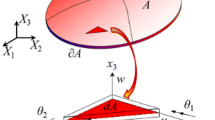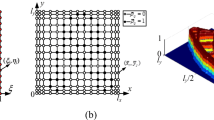Abstract
In this work, a design procedure extending the B-spline based finite cell method into shape optimization is developed for axisymmetric solids involving the centrifugal force effect. We first replace the traditional conforming mesh in the finite element method with structured cells that are fixed during the whole design process with a view to avoid the sophisticated re-meshing and eventual mesh distortion. Then, B-spline shape functions are further implemented to yield a high-order continuity field along the cell boundary in stress analysis. By means of the implicit description of the shape boundary, stress sensitivity is analytically derived with respect to shape design variables. Finally, we illustrate the efficiency and accuracy of the proposed protocol by several numerical test cases as well as a whole design procedure carried out on an aeronautic turbine disk.




















Similar content being viewed by others
References
Cheu, T.C.: Sensitivity analysis and shape optimization of axisymmetric structures. Int. J. Numer. Methods Eng. 28, 95–108 (1989)
Özakça, M., Hinton, E., Rao, N.V.R.: Shape optimization of axisymmetric structures with adaptive finite element procedures. Struct. Optim. 5, 256–264 (1993)
Francavilla, A., Ramakrishnan, C.V., Zienkiewicz, O.C.: Optimization of shape to minimize stress concentration. J. Strain Anal. Eng. Des. 10, 63–70 (1975)
Ding, Y.: Shape optimization of structures: a literature survey. Comput. Struct. 24, 985–1004 (1986)
Meng, L., Zhang, W., Zhu, J., et al.: A biarc-based shape optimization approach to reduce stress concentration effects. Acta Mech. Sin. 30, 370–382 (2014)
Xia, Q., Shi, T., Liu, S., et al.: A level set solution to the stress-based structural shape and topology optimization. Comput. Struct. 90, 55–64 (2012)
Chen, J., Shapiro, V., Suresh, K., et al.: Shape optimization with topological changes and parametric control. Int. J. Numer. Methods Eng. 71, 313–346 (2007)
Zhang, W., Beckers, P., Fleury, C.: A unified parametric design approach to structural shape optimization. Int. J. Numer. Methods Eng. 38, 2283–2292 (1995)
Zienkiewicz, O.C., Campbell, J.S.: Shape optimization and sequential linear programming. Optimum Structural Design, Chap. 7. Wiley, Chichester (1973)
Zhang, W., Wang, D., Yang, J.: A parametric mapping method for curve shape optimization on 3d panel structures. Int. J. Numer. Methods Eng. 84, 485–504 (2010)
Rank, E., Ruess, M., Kollmannsberger, S., et al.: Geometric modeling, isogeometric analysis and the finite cell method. Comput. Methods Appl. Mech. Eng. 249, 104–115 (2012)
Bennett, J.A., Botkin, M.E.: Structural shape optimization with geometric description and adaptive mesh refinement. AIAA J. 23, 458–464 (1985)
Le, C., Bruns, T., Tortorelli, D.: A gradient-based, parameter-free approach to shape optimization. Comput. Methods Appl. Mech. Eng. 200, 985–996 (2011)
Garcéra, M.J.: Fixed grid finite element analysis in structural design and optimisation [Ph. D. Thesis]. University of Sydney (1999)
Kim, H., Querin, O.M., Steven, G.P., et al.: Improving efficiency of evolutionary structural optimization by implementing fixed grid mesh. Struct. Multidiscip. Optim. 24, 441–448 (2002)
Duysinx, P., Van Miegroet, L., Jacobs, T., et al.: Generalized shape optimization using x-fem and level set methods. In: IUTAM Symposium on Topological Design Optimization of Structures. Machines and Materials, 23–32. Springer, New York (2006)
Wang, D., Zhang, W.: A general material perturbation method using fixed mesh for stress sensitivity analysis and structural shape optimization. Comput. Struct. 129, 40–53 (2013)
Wang, X., Guo, D.: A level set method for structural topology optimization. Comput. Methods Appl. Mech. Eng. 192, 227–246 (2003)
Parvizian, J., Düster, A., Rank, E.: Finite cell method: h- and p-extension for embedded domain problems in solid mechanics. Comput. Mech. 41, 121–133 (2006)
Düster, A., Parvizian, J., Yang, Z., et al.: The finite cell method for three-dimensional problems of solid mechanics. Comput. Methods Appl. Mech. Eng. 197, 3768–3782 (2008)
Ruess, M., Tal, D., Trabelsi, N., et al.: The finite cell method for bone simulations: verification and validation. Biomech. Model. Mechanobiol. 11, 425–437 (2012)
Cai, S., Zhang, W., Zhu, J., et al.: Stress constrained shape and topology optimization with fixed mesh: A b-spline finite cell method combined with level set function. Comput. Methods Appl. Mech. Eng. 278, 361–387 (2014)
Sethian, J.A.: Level Set Methods and Fast Marching Methods: evolving Interfaces in Computational Geometry, Fluid Mechanics, Computer Vision, and Materials Science. Cambridge University Press, Cambridge (1999)
Cook, R.D., Malkus, D., Plesha, M., et al.: Concepts and Applications of Finite Element Analysis. Wiley, Hoboken (2007)
Allaire, G., Jouve, F., Toader, A.M.: A level-set method for shape optimization. C. R. Math. 334, 1125–1130 (2002)
Osher, S., Fedkiw, R.: Level Set Methods and Dynamic Implicit Surfaces, vol. 153. Springer Science & Business Media, Berlin (2006)
Piegl, L., Tiller, W.: The NURBS Book. Springer Science & Business Media, Berlin (2012)
Kim, N.H., Chang, Y.: Eulerian shape design sensitivity analysis and optimization with a fixed grid. Comput. Methods Appl. Mech. Eng. 194, 3291–3314 (2005)
Clark, B.W., Anderson, D.C.: The penalty boundary method. Finite Elem. Anal. Des. 39, 387–401 (2003)
Höllig, K., Reif, U., Wipper, J.: Weighted extended b-spline approximation of dirichlet problems. SIAM J. Numer. Anal. 39, 442–462 (2001)
Rvachev, V.L.: Theory of r-functions and some applications. Naukova Dumka (Ukrainian), Kiev (1982)
Xia, L., Zhu, J., Zhang, W., et al.: An implicit model for the integrated optimization of component layout and structure topology. Comput. Methods Appl. Mech. Eng. 257, 87–102 (2013)
Acknowledgments
This work was supported by the National Natural Science Foundation of China (Grant 51275424), 973 Program (Grant 2011CB610304), Research Fund for the Doctoral Program of Higher Education of China (Grant 20126102130003) and the opening project (Grant KFJJ13-6M) of the State Key Laboratory of Explosion Science and Technology (Beijing Institute of Technology). The first author is greatly thankful to Professor Piotr BREITKOPF, Université de Technologie de Compiègne, France.
Author information
Authors and Affiliations
Corresponding author
Rights and permissions
About this article
Cite this article
Meng, L., Zhang, WH., Zhu, JH. et al. Shape optimization of axisymmetric solids with the finite cell method using a fixed grid. Acta Mech. Sin. 32, 510–524 (2016). https://doi.org/10.1007/s10409-015-0549-8
Received:
Revised:
Accepted:
Published:
Issue Date:
DOI: https://doi.org/10.1007/s10409-015-0549-8




